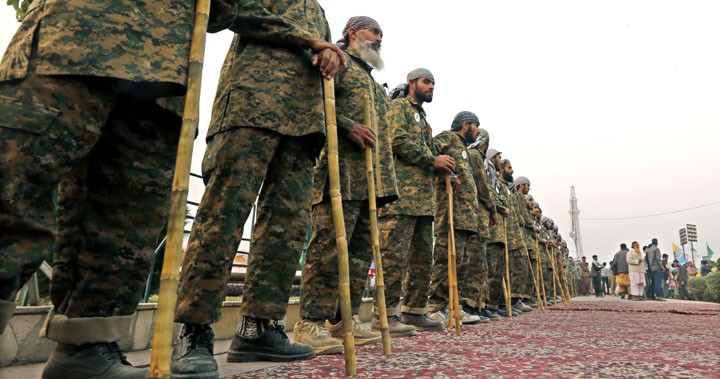
The rise of jihadi culture and weak state institutions are stumbling block to modern education and outlook

Today religious extremism, in its various facets and manifestations, is the biggest threat faced by Pakistan. These facets of religious extremism range from extreme right wing views of a great majority of our citizens, to the outright militant movement of TTP, who declare their avowed goal to be the overthrow of, in their opinion, the un-Islamic government of Pakistan. Many of our religious and rightist political parties and their followers may disagree with their violent means but are generally sympathetic to the cause of these Islamists.
Due to the overt religious policies and propaganda of successive regimes, Pakistan over the years has become a reactionary and intolerant place. This was not always the case. In its earlier years, Pakistan was more liberal and pluralistic where members of other faiths and minority groups were tolerated. In today’s Pakistan when most people are riding high on a crest of false religiosity, such tolerance is rare. To fully comprehend the phenomenon of religious extremism, it would be helpful to briefly delve into the history of Pakistan movement, and the political and religious orientations of our various governments and state institutions.
Intellectual confusion has been pervasive in our society ever since the conception of Pakistan. Liberal leaders like Jinnah had to use the religious card -- to get overwhelming support of Muslims -- that was required for the creation of the new state. This was, however, to be a temporary phase. In Jinnah’s and his associates’ view, a Muslim welfare state, and not an Islamic theocratic state, was the goal. It was only after Jinnah’s death that the narrative of the Islamic State gained ascendancy through an alliance between the military, the mullahs; right wing politicians, and pro-establishment bureaucrats.
The objective resolution of 1949, for the first time, clearly highlighted the Islamic character of the Pakistani State. This resolution was passed against the opposition of the minority members in the legislative assembly at that time. Religious parties like Jamaat-e-Islami who initially opposed the creation of Pakistan, became very close to the army, and played an important role in dictating the Islamic agenda. The Jamaat spearheaded the anti-Ahmadi riots of 1950s, and the creation of Al- Shams and AL Badr in East Pakistan in 1971. The Jamaat-e-Islami was an important partner of Zia regime in its initial years.
These retrogressive religious forces forced even a secular and pro-socialist leader like Zulfikar Ali Bhutto, to do their bidding. The declaration of Ahmadis as non-Muslims was the most important of these decisions. Pakistan thus became the first and perhaps, the only country in the world to declare Ahmadis non-Muslims.
The self-serving and opportunistic Islamic policies of general Zia, gave a further fill up to overt religiosity, leading to religious extremism. On the external front, Zia involved Pakistan neck deep in the Afghan Jihad against the Soviet invasion.
Pakistan became a refuge for over three million Afghan refugees. Various Afghan Jihadi outfits established their headquarters and training camps in Pakistan. With the financial support from both the US and Saudi Arabia, religious elements of all hue were recruited in Pakistan -- they came from all over the world to take part in the Afghan Jihad.
The erroneous concept of strategic depth prompted our defense establishment to help and nurture the Afghan Taliban in order have a friendly government in Kabul. A Jihadi culture was thus established in Pakistan, from where militants went to fight not only in Afghanistan. The saddest part of all this was the total oblivion of our governments and defense establishment to the pernicious long time effects of this Jihadi enterprise, carried out right under the nose of our authorities.
The turning point for Pakistan came after 9/11, when Musharraf under US pressure had to take a U-turn against the Afghan Taliban. Many of these Afghan Taliban along with their al Qaeda supporters took refugee in Pakistani tribal areas. Very soon Tehreek-i-Taliban Pakistan (TTP) was born who turned their guns on the state of Pakistan.
An existential threat to Pakistan from this religious militancy was thus created. The existence of our state as well as our way of life came under threat. Our successive governments and even our army have not responded to this threat as earnestly as was required under the influence of right wing religious and political forces.
Even in the present North Waziristan operation, it seems the army forced the PML-N government to agree to a full-fledged operation, rather than waste more time. Pakistan army seems earnest in eradicating the Jihadi culture, which reflects a change of mind in the army high command. Many religious parties like Jamaat-e-Islami and JUF are still against the operation. Tehreek-i-Insaf has very reluctantly and perhaps insincerely supported the operation.
In the absence of any counter-narrative by our governments, the retrogressive Jihadi narrative preached by religious parties and militant outfits hold the field in Pakistan. We need to go back to the narrative of a modern Muslim nation state. It will not be easy as the theocratic forces are so well entrenched. The combination of jihadi culture and weak state institutions leads to resistance to modern education and outlook that is so essential for survival of a complex society such as ours.